The United States is home to around thirty species of venomous snakes, some of which can be found in Oregon. To learn more about the venomous snakes in Oregon, keep reading.
Ready to learn about the snakes of Oregon? Let’s dive in!
What’s the Difference Between Venom and Poison?
There’s often a lot of confusion surrounding whether snakes are venomous or poisonous. However, a quick look at venom vs. poison will show that they’re both unique topics. Learning the difference may also help prevent a potential negative encounter in the future!
Both venom and poison are types of toxins that are harmful chemicals. They impact the body in different ways, however. Venom is a toxin that has to be injected into the body to have an effect. For instance, a snake will bite you and then inject venom. However, the poison must be inhaled or consumed, which is like eating a poisonous mushroom.
Even knowing this, it can be difficult to remember. After all, it’s not uncommon to see both terms used interchangeably despite their differences. The bite rule is the best way to remember the difference between venom and poison. If you bite something and it hurts you, it’s poisonous, and if something bites you and hurts you, it’s venomous.
Now that you know the difference between poison and venom, you can learn about the venomous snakes of Oregon.
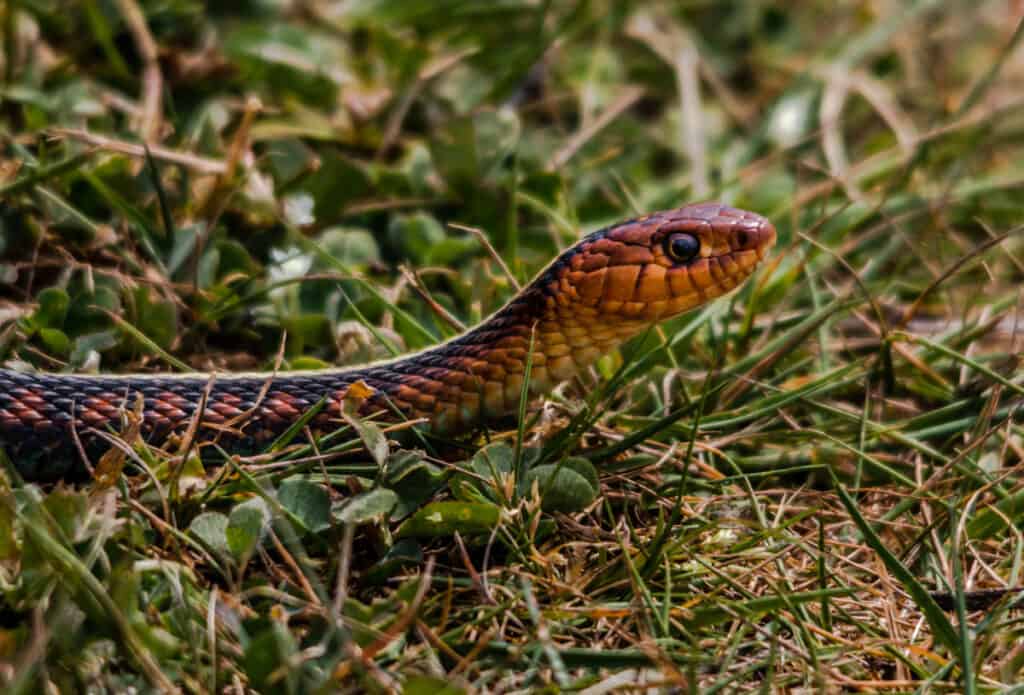
The bite rule is the best way to remember the difference between venom and poison.
©iStock.com/raywhittemore
The Venomous Snakes of Oregon
There’s only one venomous snake species in Oregon: the northern Pacific rattlesnake (Crotalus oreganus). However, it’s not the only venomous snake. There’s also the Great Basin rattlesnake (Crotalus lutosus). Despite their different names, this venomous snake is a subspecies of the northern Pacific rattlesnake. As a result, while there is only one species of venomous snakes in Oregon, there are two different types.
The northern Pacific rattlesnake can be found across North America. However, their habitat is mostly distributed along the western portion of the continent, and they’re especially common in the Rocky Mountains.
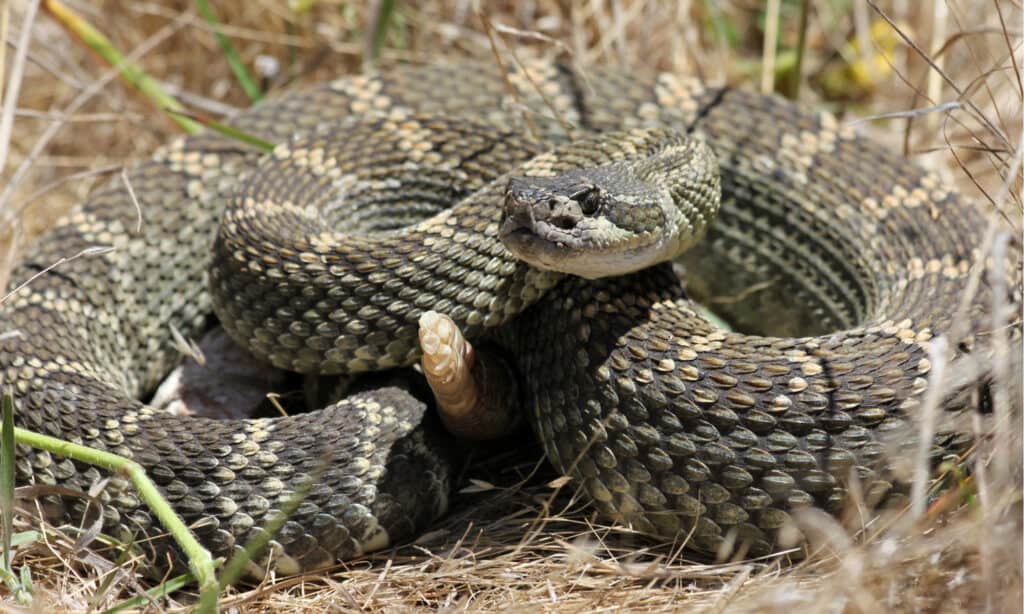
The northern Pacific rattlesnake is the only venomous snake in Oregon.
©Ryan M. Bolton/Shutterstock.com
Other Snakes Native to Oregon
Although there is only one venomous snake species in Oregon, it’s not the only snake you’ll find here. In fact, there are fourteen other species of snakes native to Oregon and countless subspecies to be found here. To learn more about the snakes other than the venomous snakes in Oregon, keep reading below.
1. California Mountain Kingsnake
| Species | Lampropeltis zonata |
| Lifespan | Up to 26 years |
| Size | 20 to 48 inches |
| Appearance | Red, black, and yellow stripes |
Although they’re named for California, these mountain kingsnakes can also be found in Oregon. In fact, they’re native to the state.
There are seven different subspecies of California mountain kingsnake. Despite their name, you can find all seven in various habitats across North America. Five subspecies are found in the United States, while only two are found in Mexico.
The California mountain kingsnake mimics the appearance of the venomous coral snake. This helps keep them safe from predators. However, it can also prove tricky for humans to tell the difference. If you’re having trouble telling the kingsnake apart from its venomous lookalikes, remember this rhyme: black on yellow will kill a fellow; red on black, give it some slack. This means that if the red and black stripes are touching, it’s a non-venomous species. However, if it’s black and yellow touching, it is a venomous species.
Oregon also has other kingsnake species, although they are much easier to distinguish from the California mountain kingsnake.
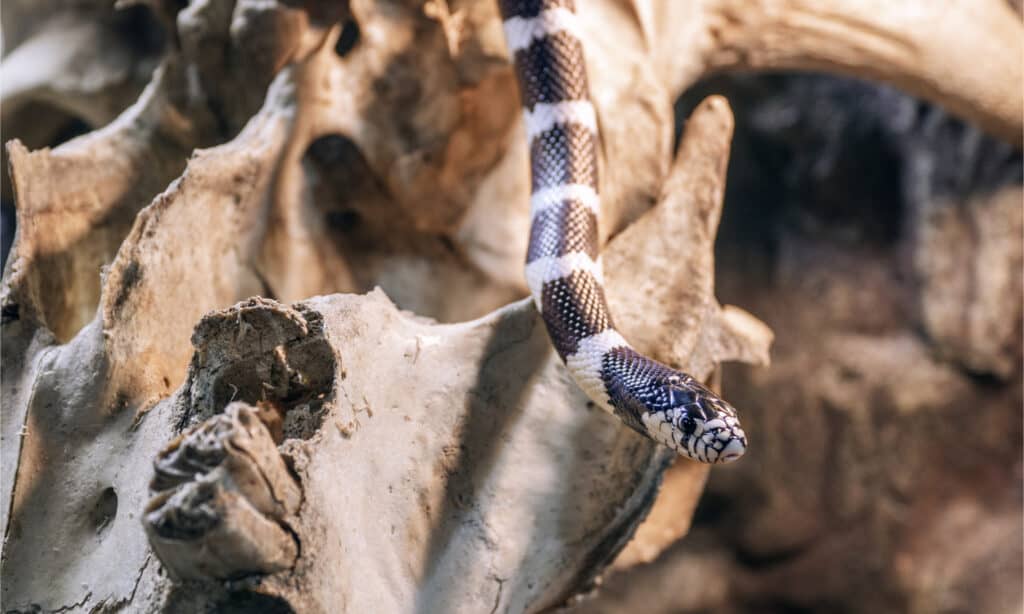
The California mountain kingsnake can come in various morphs, but all feature stripes or bands.
©Ann May Snz/Shutterstock.com
2. Common Garter Snake
| Species | Thamnophis sirtalis |
| Lifespan | Up to 14 years |
| Size | Up to four feet |
| Appearance | Depends on subspecies |
There are thirteen different subspecies of the common garter snake. However, only two are found in Oregon: the valley garter snake (T. s. Fitchi) and the red-spotted garter snake (T. s. concinnus). Although they may seem similar, the common garter snake is a different species than the northwestern garter snake, another Oregon snake.
The common garter snake is one of the most common snakes in North America. They can be found virtually everywhere in the United States, although they’re not as common in Canada or Mexico. The only place you won’t find this species in the United States is the Great Plains region.
Like many other snakes on this list, Oregon’s common garter snake is not venomous. However, its saliva does have a paralyzing venom that is good for hunting amphibians and other small animals. They also have a unique immunity to the poison of certain animals, including those that may be fatal to humans! This includes the cane toad as well as different species of newt.

All garter snakes have keeled scales, which means they have a ridge down the center.
©iStock.com/Wildnerdpix
3. Common Kingsnake
| Species | Lampropeltis getula |
| Lifespan | Up to 25 years |
| Size | 36 to 42 inches |
| Appearance | Black with thin white bands |
The common kingsnake has many names. Some of these include the eastern kingsnake, the common kingsnake, and the chain kingsnake.
Although they’re similar, it’s important not to mistake the common kingsnake for the California mountain kingsnake. However, this can be easy as the common kingsnake lacks the bright colors of the California mountain kingsnake. Instead, they feature a mostly black body with thin white bands. While black is the most common, it may occasionally be a different color, like brown. Their exact appearance depends on the subspecies and their location.
Another harmless, nonvenomous snake in Oregon, the common kingsnake, is kept as a pet by many snake lovers. There are nine different subspecies, and at least one subspecies is found in most of the United States, although many subspecies have overlapping ranges.
Although the largest subspecies of common kingsnake only grows to be 42 inches long on average, this isn’t a hard limit. There have been claims of common kingsnakes growing much longer, with the largest ever recorded reaching over 60 inches in length!
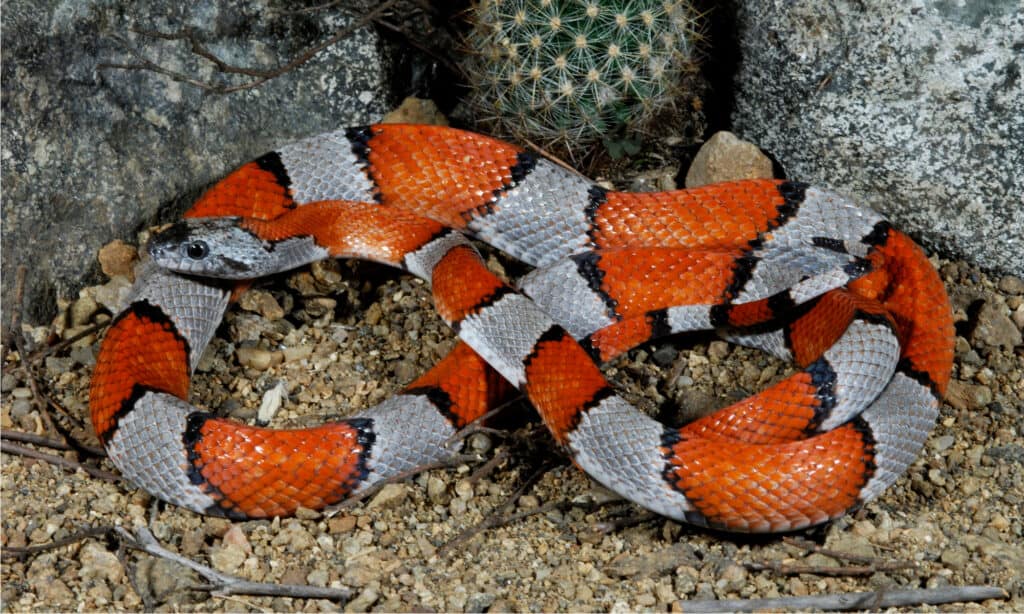
The kingsnake is designed to mimic the coral snake, a venomous species.
©Breck P. Kent/Shutterstock.com
4. Gopher Snake
| Species | Pituophis catenifer |
| Lifespan | Up to 33 years |
| Size | 36 to 84 inches |
| Appearance | Yellow or pale brown with dark markings |
The gopher snake resembles the only venomous snake in Oregon. As if this isn’t confusing enough, they’ve also evolved to shake their tails to resemble the tell-tale rattle of the rattlesnake. Like the California mountain kingsnake, this is a way to protect themselves from predators. The best way to tell the difference between these two species is to pay attention to the finer details. The gopher snake lacks the same black and white band on its tail that the northern Pacific rattlesnake has, and it also has a much narrower head thanks to its lack of venom glands.
If you happen to come across a gopher snake, one of the most interesting things you’ll notice is how they “attack.” You see, with rattlesnakes, after they give their warning if you don’t leave, they will strike with an open mouth and the intention to bite. However, the same cannot be said for their lookalike. The gopher snake prefers to strike with a closed mouth, using its blunt nose as another way to say, “Leave me alone.”
There are many common names for the gopher snake, including the Pacific gopher snake, the coast gopher snake, and the western gopher snake. There are also nine different subspecies.
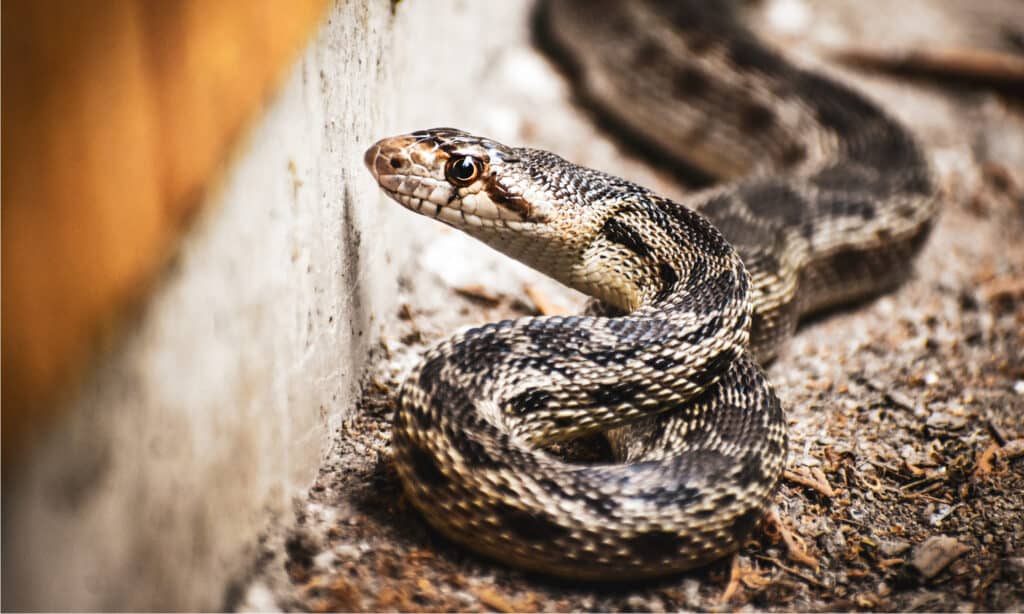
The gopher snake closely resembles the northern Pacific rattlesnake.
©Cedar Dobson/Shutterstock.com
5. Night Snake
| Species | Hypsiglena torquata |
| Lifespan | Up to 12 years |
| Size | 12 to 26 inches |
| Appearance | Lightly colored with dark splotches |
Not much is known about the night snake, and it can be found east of Texas, ranging from Canada to Mexico. They also have a venom that isn’t dangerous to humans but does help them during hunting.
While most snakes tend to have a select few areas to call home, the night snake lives in various places. There are few places they won’t go, from grasslands to mountains to deserts. They’ve even been recorded living inside of the burrows of other mammals!
Like the gopher snake, the night snake is often mistaken for a rattlesnake. This is because they have a slightly triangular head, mimicking a venomous snake’s diamond shape. In fact, they’ve even been known to share dens with rattlesnakes at times. However, despite the similarities to the venomous snakes of Oregon, the night snake doesn’t pose a threat to humans.
One of the most distinguishing features is its fangs. Unlike other snakes, which have their fangs up front where they can be seen, the night snake has fangs at the back of its mouth.
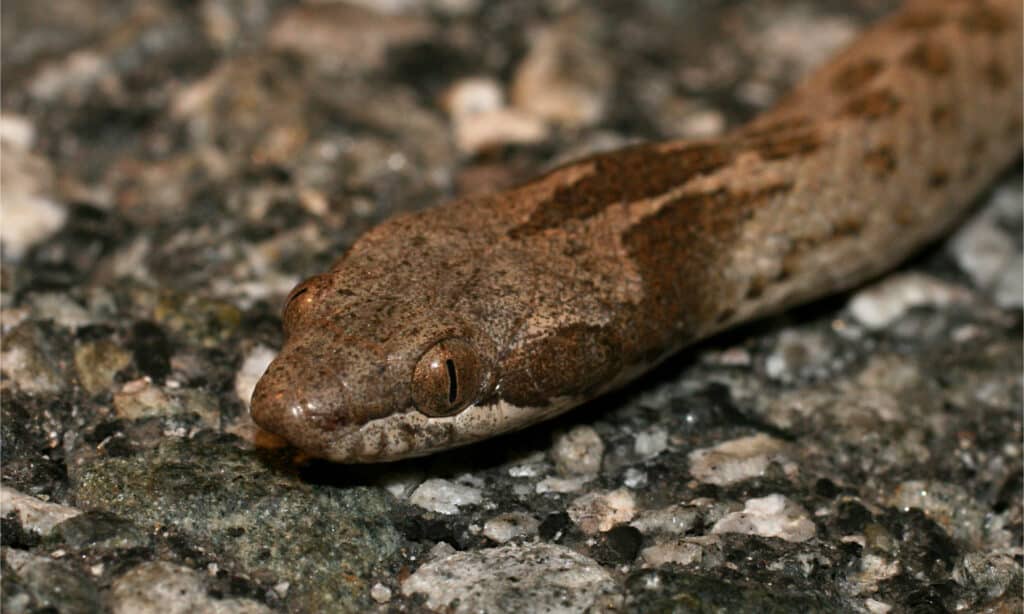
Night snakes get their name from their nocturnal behavior.
©Casey K. Bishop/Shutterstock.com
6. Northwestern Garter Snake
| Species | Thamnophis ordinoides |
| Lifespan | Up to 16 years |
| Size | 13 to 38 inches |
| Appearance | Varies greatly |
Although the northwestern garter snake is similar to the common garter snake, they’re not the same species but in the same genus.
The northwestern garter snake is usually found in forest meadows where there is plenty of access to sunlight and other necessary resources. However, they don’t thrive well in extremely hot conditions. If the temperature starts to creep too high for these small snakes in Oregon, they’ll seek shelter in the shade, usually under fallen logs and stumps.
Despite their ability to grow to 38 inches long, the northwestern garter snake has a fairly limited diet. They eat slugs and certain types of amphibians, like salamanders and frogs.
While many snakes like to form close friendships and social relationships with each other, the northwestern garter snake is not included. These snakes are solitary and like to spend their time alone. During the day, they’ll hunt for food before resting on their own. They do come together to breed, however. Males can find mates using their tongues to smell the air, allowing them to pick up different chemicals.
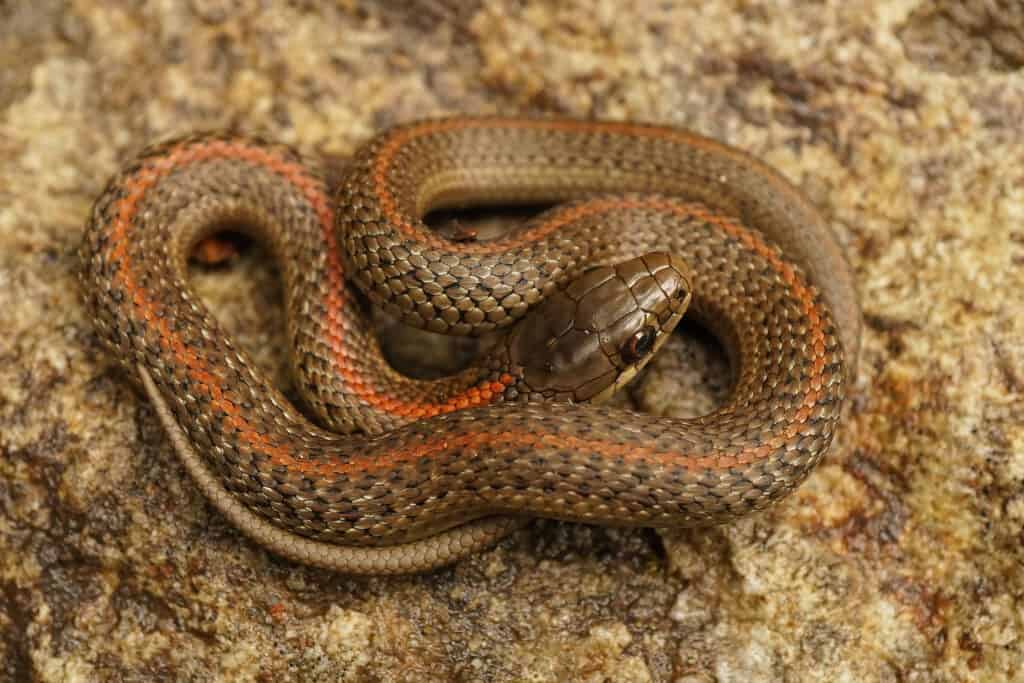
Northwestern garter snakes feature the tell-tale stripe pattern.
©HWall/Shutterstock.com
7. Aquatic Garter Snake
| Species | Thamnophis atratus |
| Lifespan | Up to five years |
| Size | 18 to 40 inches |
| Appearance | Several different patterns ranging from light to dark |
The aquatic garter snake is only found along the coast of Oregon and California. However, three different subspecies are found here despite having such a small habitat area. This includes
- Santa Cruz garter snake (T. a. atratus)
- Oregon garter snake (T. a. hydrophilus)
- Diablo Range garter snake (T. a. zaxanthus).
Although they are aquatic, the aquatic garter snake doesn’t live in water. Instead, they chose to live near it. This means that you can most commonly find them in areas around ponds, lakes, streams, or even marshes. However, since these bodies of water can pop up in many different areas, the aquatic garter snake has a diverse habitat. They can live everywhere, from forests to grasslands on the United State’s west coast.
Instead, the aquatic garter snake gets its name from its lifestyle. While it doesn’t live in the water, it spends much time there. For instance, since they’re small, these garter snakes aren’t considered strong predators. In fact, they’re more likely to end up as prey when it comes to anything but small fish, insects, and amphibians. As a result, whenever they feel threatened, they will rush to the nearest body of water for shelter.
They also hunt in the water using interesting angling techniques. They will flick their tongue to mimic the motions of an insect. This attracts small fish to them, which provides them with food.
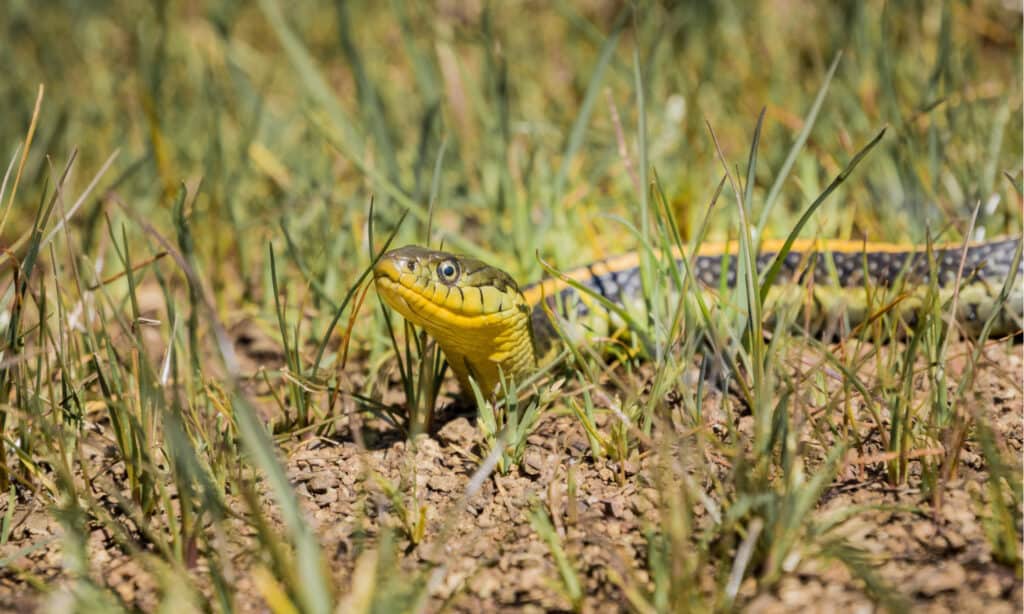
The aquatic garter snake doesn’t live in water – just near it.
©Sundry Photography/Shutterstock.com
8. Ringneck Snake
| Species | Diadophis punctatus |
| Lifespan | Up to 20 years |
| Size | 10 to 15 inches |
| Appearance | Colors vary, although they do have a singular band around their neck. |
Like other species of nonvenomous snakes in Oregon, the ringneck snake is venomous. However, they’re not considered dangerous to humans, so we don’t consider them the same as rattlesnakes. Instead, they have a weak bite, and their venom is designed for smaller critters – not humans. As a result, they are virtually harmless to humans and are also common pets!
The ringneck snake has a pretty diverse diet. Although they mainly eat smaller animals such as salamanders, slugs, and earthworms. They also eat lizards, frogs, and even smaller snakes!
Despite being one of the more common snakes in the United States, there’s little known about the social life of ring-necked snakes. Although we know they may live in colonies, they’re secretive reptiles. They tend to be most active at night, although they can be seen during the day sun basking. While they can gain warmth from the sun, they prefer to lay on rocks and other objects warmed by the sun and use their heat instead.
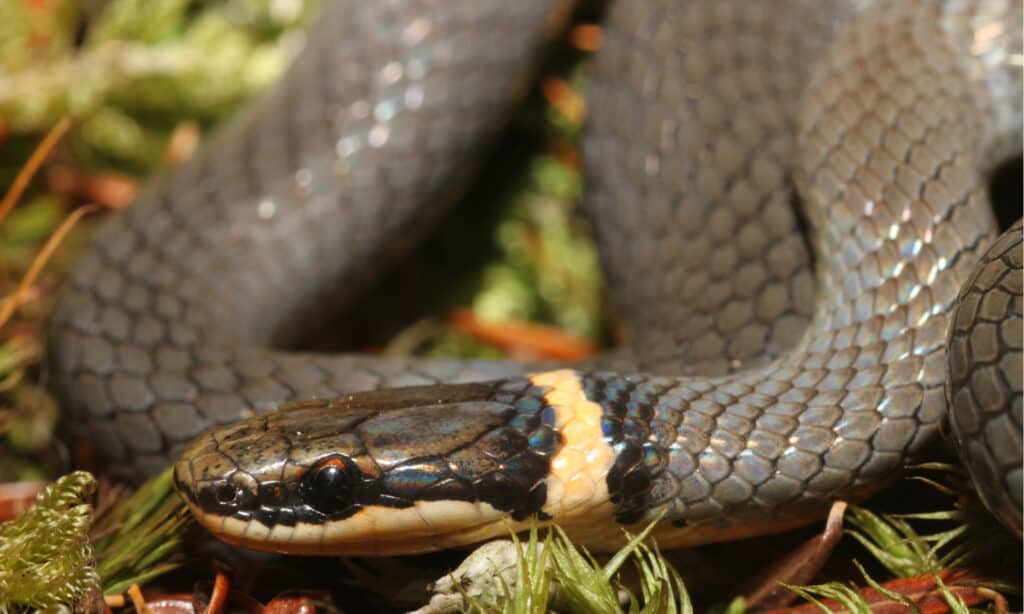
Ringneck snakes are named for their colorful bands.
©/Shutterstock.com
9. Rubber Boa
| Species | Charina bottae |
| Lifespan | Up to 50 years |
| Size | 15 to 33 inches |
| Appearance | Tan to dark brown |
The rubber boa, also known as the coastal rubber boa or the northern rubber boa, is a snake commonly found in Oregon. It’s important not to mistake it for the southern rubber boa, a completely different species. However, it was once questioned whether or not the southern rubber boa should be considered a subspecies, although this idea was rejected in 2001.
This snake is a type of boa. This means it catches its prey through constriction and then swallows it whole. Typically, boas aren’t found in North America, and most boas thrive in tropical climates. As a result, the rubber boa is considered the most northern boa species. They’re found in the northwest of the United States. Along with Oregon, they can be seen in California, Washington, Nevada, Utah, Wyoming, Montana, and Idaho. They’re also a common sight in British Columbia.
If you’re afraid of snakes and looking for a docile species to help you overcome them, the rubber boa is the place to start. The rubber boa is considered to be the gentlest of all snakes. And they’re used to help with ophidiophobia, the fear of snakes.
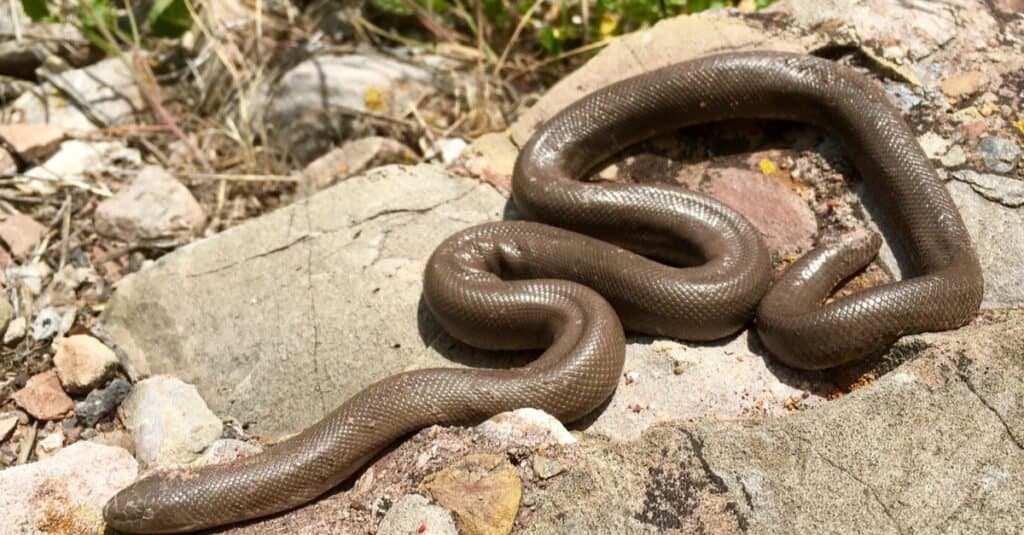
Rubber boas are docile and gentle.
©Matt Jeppson/Shutterstock.com
10. Sharp-Tail Snake
| Species | Contia tenuis |
| Lifespan | Up to 10 years |
| Size | 12 to 18 inches |
| Appearance | Dark to light red back with black and white belly |
The sharp-tail snake is probably one of the most interesting snakes in Oregon. While all snakes are special in their ways, the sharp-tail snake has a unique characteristic: a sharp tail. This snake is named for its sharp spine extending from its tail, which is a bone — specifically the tip of its last vertebrae.
While this may make them seem more scorpion than a snake, this pointy tail isn’t toxic. In fact, it’s completely harmless to humans. Instead of hunting with it, the sharp-tail snake uses its namesake to help stabilize prey. Their diet includes slugs and eggs.
There are many different names for the sharp-tail snake. Some of these include the sharp-tailed snake, brown snake, gentle brown snake, and Oregon worm snake. These names help demonstrate one of the main qualities of the sharp-tail snake: its gentleness. These are shy snakes that don’t like confrontation. They’re often found under logs and stones, and they’re known to curl into a ball when threatened. This causes many people to mistake them for worms, especially younger ones.

The sharp-tail snake is named for its sharp spine at its tail’s end.
©Bill Bouton / CC BY-SA 2.0 – License
11. Striped Whipsnake
| Species | Masticophis taeniatus |
| Size | 36 to 72 inches |
| Appearance | Olive to grey coloration with light stripes |
The striped whipsnake is named for its appearance. First, it has a long, slender body that many consider similar to a whip. It also has stripes running down the entirety of its body. It’s also incredibly fast.
Active during the day, you can find the striped whipsnake in various habitats. They like everything from grasslands to canyons to forests and even streams. There are two different species of this type of Oregon snake: Masticophis taeniatus girardi and Masticophis taeniatus taeniatus.
The striped whipsnake is a nonvenomous snake. However, they have no problem hunting down a variety of prey. They eat everything from insects and small mammals to small birds and even other snakes. This includes other types of venomous snakes! Don’t worry, though. Even though they’re not venomous, the striped whipsnake, like all other types of snakes, has a special stomach designed to digest venom. This means that even eating venomous snakes won’t harm them.
If you happen to stumble across the striped whipsnake, don’t worry. Unless you startle or actively threaten them, they won’t confront you. Instead, they’ll use their whip-like speed to escape.

Striped racers have been known to reach 6 feet.
©Matt Jeppson/Shutterstock.com
12. Western Ground Snake
| Species | Sonora semiannulata |
| Lifespan | Up to 20 years |
| Size | 8 to 19 inches |
| Appearance | Varies greatly |
Also known as the common ground snake or variable ground snake, the western ground snake is known for its widely varying appearance. They can be solid-colored or patterned and come in colors ranging from brown to orange.
Most snakes have unique eyes that you can recognize. They’re similar to cats’ eyes, with slits rather than pupils like humans. This is true for most snakes – but now the western ground snake. The western ground snake has a round pupil.
It can be difficult to tell whether or not the western ground snakes have subspecies because they are so diverse. Many scientists refer to five different subspecies, but these aren’t set in stone. This is because they don’t follow the same rules as other subspecies, with different types of western ground snakes sharing appearances and the ability to breed with one another.
Because of their small size, the western ground snake is a harmless species of nonvenomous snake. They’re shy and not even interested in hunting larger mammals and amphibians. Instead, you’ll find that they prefer to eat insects like crickets, spiders, and even insect larvae.
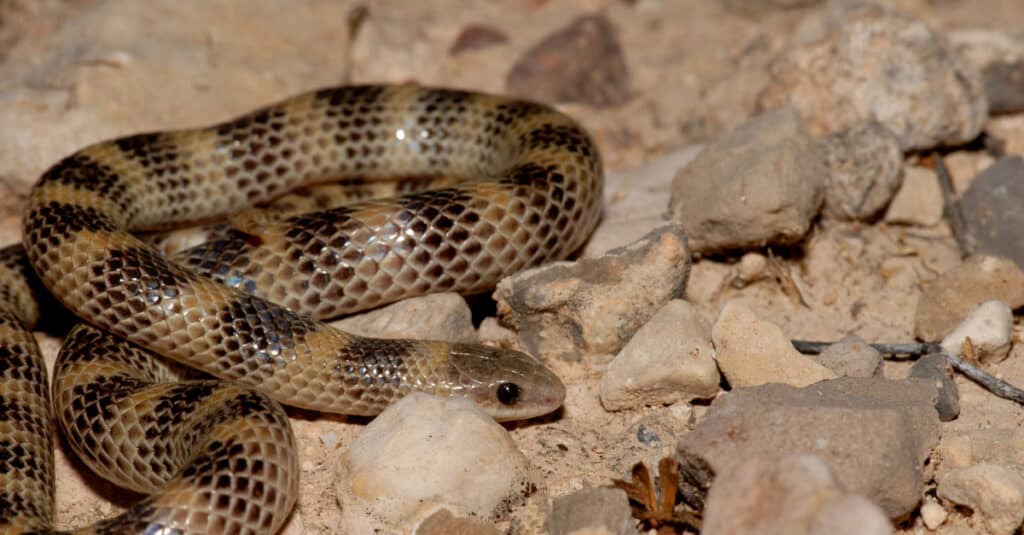
Western Ground Snakes have round pupils.
©Rusty Dodson/Shutterstock.com
13. Western Terrestrial Garter Snake
| Species | Thamnophis elegans |
| Lifespan | Up to 18 years |
| Size | 18 to 41 inches |
| Appearance | Light colors with stripe pattern |
The western terrestrial garter snake is another type of garter snake. This means they share many of the same characteristics. This includes venomous saliva. Although this doesn’t affect humans, it can be beneficial in catching different types of prey.
The exact prey that the western terrestrial garter snake will eat depends greatly on what is available to them. This means that a western terrestrial garter snake in one area may have a different diet than one in a different area. However, they’ve been known to eat everything from slugs to small mammals to fish.
There are six different subspecies of western terrestrial garter snake. However, not all are formally recognized.
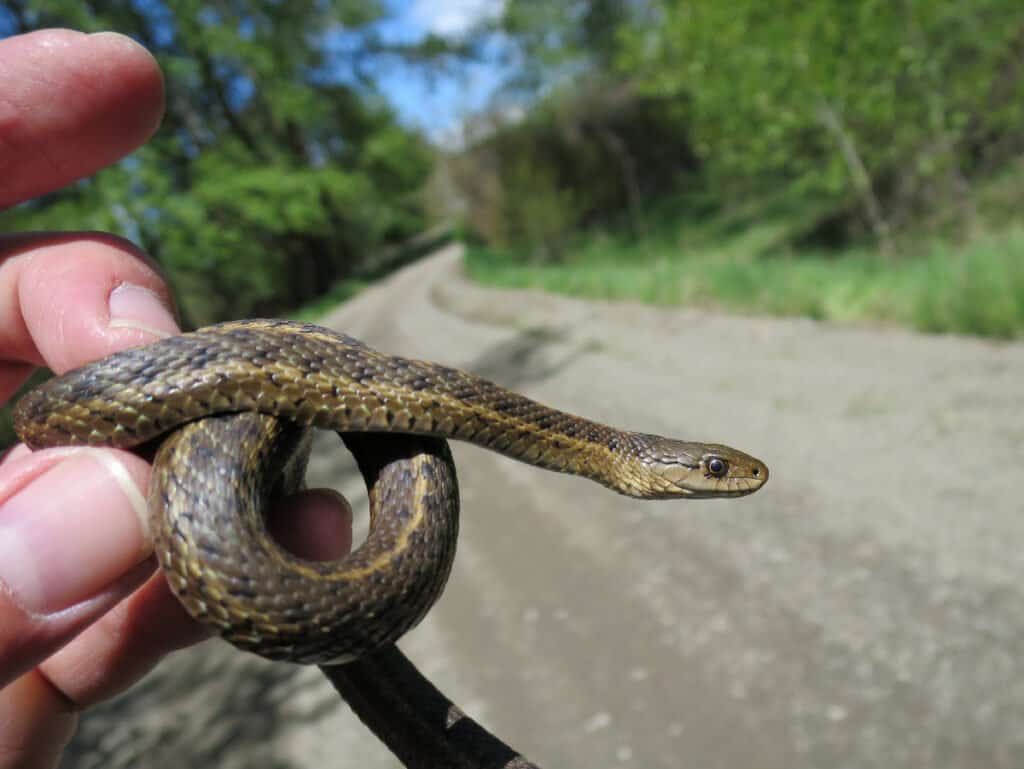
The western terrestrial garter snake has a mildly venomous saliva that won’t affect humans.
©Randy Bjorklund/Shutterstock.com
14. Western Yellow-Bellied Racer Snake
| Species | Coluber constrictor mormon |
| Lifespan | Up to 20 years |
| Size | Up to 8 feet |
| Appearance | Grey with yellow underside |
The western yellow-bellied racer snake is also known as the western racer. This species of racer snake is found only in the western United States in a few choice states, including California, Oregon, Nevada, New Mexico, Utah, Montana, and Colorado. The western yellow-bellied racer is a subspecies of the racer snake, which is found more ubiquitously.
You can find the western yellow-bellied racer snake in most habitats across Oregon. Their interesting coloration and pattern make it easy to mistake them for other snakes when they’re younger. Some of these lookalikes include the venomous western rattlesnake and the gopher snake. It can become easier to identify them once they mature and develop their namesake yellow bellies.
Although their scientific name involves the word constrictor, the western yellow-bellied racer snake isn’t a constriction snake. Instead, like many other snakes in Oregon, they swallow their food whole.
Several other species and subspecies of racer snakes are found throughout North America, and many species call the United States their home. However, many of these are found further east, either in the Midwest or on the East Coast itself.
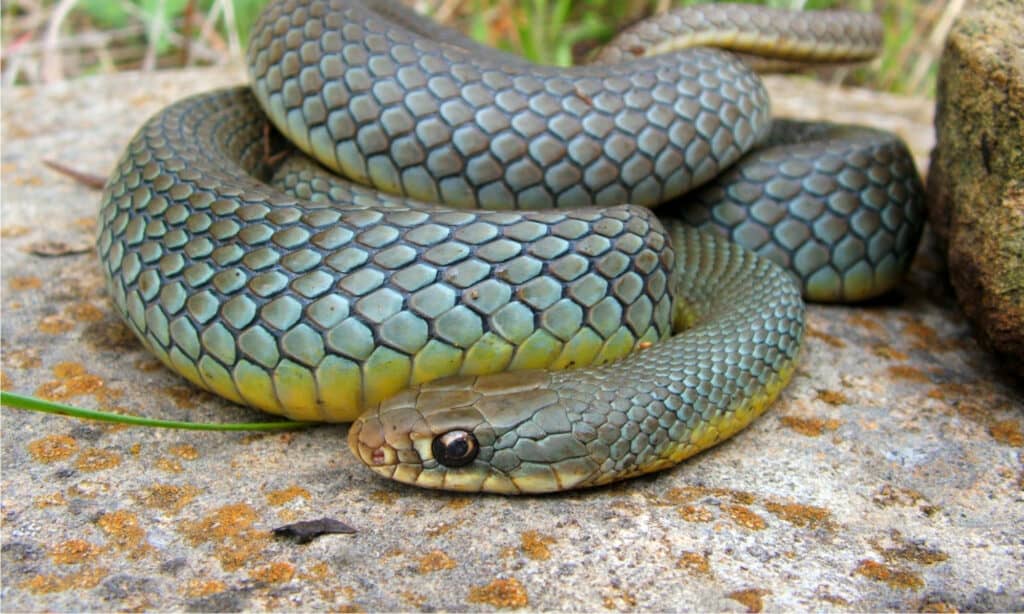
The western yellow-bellied racer is a subspecies of the eastern variation.
©Matt Jeppson/Shutterstock.com
The photo featured at the top of this post is © Michael Benard/Shutterstock.com
Discover the "Monster" Snake 5X Bigger than an Anaconda
Every day A-Z Animals sends out some of the most incredible facts in the world from our free newsletter. Want to discover the 10 most beautiful snakes in the world, a "snake island" where you're never more than 3 feet from danger, or a "monster" snake 5X larger than an anaconda? Then sign up right now and you'll start receiving our daily newsletter absolutely free.
Thank you for reading! Have some feedback for us? Contact the AZ Animals editorial team.






